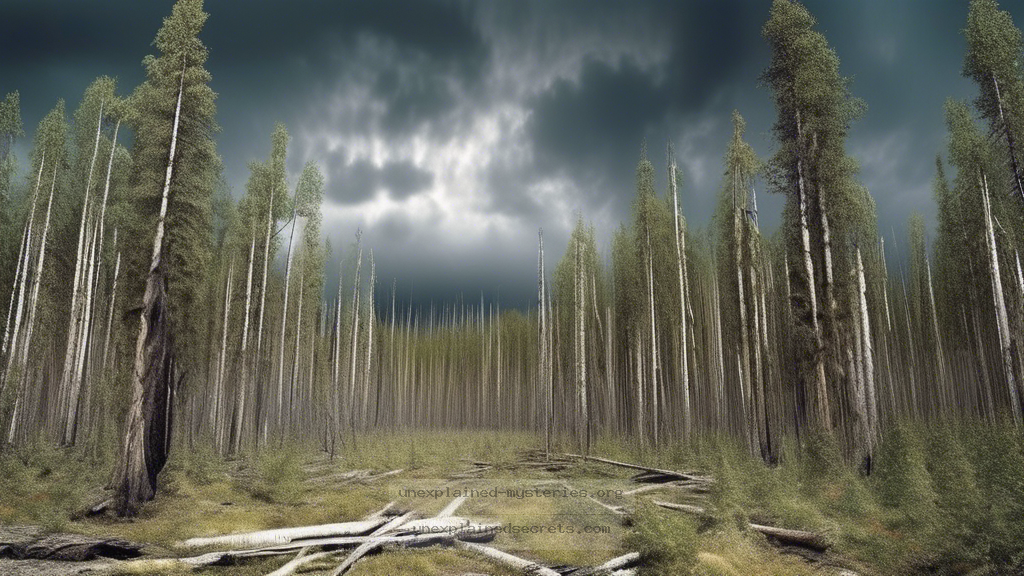What is the Mystery Behind the Tunguska Event and Its Unexplained Scientific Anomalies?
What is the Mystery Behind the Tunguska Event and Its Unexplained Scientific Anomalies?
The Tunguska event, which occurred on June 30, 1908, is one of the most enigmatic incidents in modern scientific history. A massive explosion occurred over the remote Siberian Taiga, flattening approximately 2,000 square kilometers of forest and causing seismic disturbances felt hundreds of miles away. What makes this event particularly compelling is the ongoing debate regarding its cause. Was it a meteorite, a comet, or something even more extraordinary? Understanding the Tunguska event is not only essential for grasping the history of our planet but also for recognizing potential threats from space. This post will dive deep into the various theories, evidence, and implications surrounding this scientific anomaly.
Historical Context of the Tunguska Event
The Tunguska event did not go unnoticed. Local witnesses reported seeing a bright fireball streaking across the sky, followed by a massive explosion that flattened trees and produced heat waves felt miles away. The Russian government initiated an investigation led by Leonid Kulik in 1927, but the remoteness of the area delayed thorough examinations for decades. The first substantial reports were not published until years later, sparking interest in the scientific community and conspiracy theorists alike.
For decades, the Tunguska event has been the subject of much speculation. Theories ranged from natural phenomena to extraterrestrial encounters. The lack of a crater, typically expected from such a massive explosion, further fueled the intrigue. Historical accounts suggest that the event was so powerful that it could be likened to the energy released by a hydrogen bomb. Scientists have since sought to understand its implications, not only for Earth’s geology but also for planetary defense against celestial threats.
Core Theories Behind the Event
Several leading theories attempt to explain the Tunguska event, each with its own set of evidence and implications. The most widely accepted theories include:
- Meteorite or Comet Impact: The traditional explanation posits that a small comet or asteroid exploded in the atmosphere, releasing energy equivalent to 10-15 megatons of TNT. This is supported by the tree-fall pattern, which radiates outward from a central point.
- Nuclear Explosion: Some conspiracy theorists have suggested that the explosion was the result of a secret Soviet weapon test. However, this theory lacks credible evidence and is widely dismissed by scientists.
- Natural Gas Explosion: Another theory posits that a release of methane gas from the permafrost could have caused the explosion, although this does not explain the fireball seen by witnesses.
Practical Implications of Understanding Tunguska
Understanding the Tunguska event is crucial for several reasons. Firstly, it serves as a reminder of the potential dangers posed by near-Earth objects (NEOs). The explosion was powerful enough to destroy a city, highlighting the need for ongoing monitoring of celestial bodies that could pose a threat to Earth.
Secondly, the Tunguska event provides insights into Earth’s geological processes. Studying the remnants of such an explosion can yield valuable information about past impacts on Earth, helping scientists understand how these events shape the planet’s geology and atmosphere over time. Additionally, this understanding aids in developing predictive models to assess the risks of future impacts.
Evidence Supporting the Meteorite Theory
Several pieces of evidence support the theory that the Tunguska event was caused by a meteorite or comet. For one, the explosion’s energy output aligns with estimates from similar impact events recorded in history. Furthermore, satellite imagery and ground-penetrating radar have revealed unusual geological features in the region, possibly linked to the event.
Additionally, scientists have found micro-particles in the area that resemble materials found in asteroids and comets. In 2007, a team of researchers even identified a small crater in the nearby Lake Cheko, although its size and formation remain subjects of debate. This has been crucial in bolstering the impact hypothesis.
Alternative Perspectives: The Extraterrestrial Hypothesis
While the meteorite theory is widely accepted, alternative perspectives have emerged, particularly the extraterrestrial hypothesis. This theory suggests that the explosion could have been caused by an alien spacecraft or technology. Proponents of this theory point to the lack of physical evidence typically associated with meteorite impacts and the mysterious nature of the explosion.
However, this hypothesis lacks substantial scientific backing and is often dismissed by the scientific community. The absence of credible evidence, such as fragments of alien technology or biological material, makes it difficult to validate. Nevertheless, it remains a fascinating aspect of the broader narrative surrounding the Tunguska event.
Common Misconceptions and Clarifications
Several misconceptions have arisen around the Tunguska event, which are worth clarifying:
- Myth: There was no damage. Reality: The explosion caused extensive damage, flattening over 80 million trees and affecting wildlife in the area.
- Myth: It was a nuclear explosion. Reality: While the explosion was powerful, there is no credible evidence to suggest that it was of nuclear origin.
- Myth: The event is well understood. Reality: Despite significant research, many aspects of the Tunguska event remain mysterious and are still actively studied.
Best Practices for Investigating Scientific Anomalies
Investigating scientific anomalies like the Tunguska event requires a structured approach. Here are some best practices:
- Gather Multidisciplinary Evidence: Utilize expertise from geology, astronomy, and physics to build a comprehensive understanding of the event.
- Employ Modern Technology: Use satellite imagery, ground-penetrating radar, and drones for data collection.
- Engage with the Scientific Community: Collaborate with researchers across various fields to corroborate findings and interpret data accurately.
Future Developments and Ongoing Research
Ongoing research into the Tunguska event continues to reveal new insights. In recent years, scientists have utilized advanced technologies such as cosmic-ray muon tomography to explore the region for potential missing evidence. Researchers are also looking into the long-term ecological impacts of the explosion, seeking to understand how the local environment has changed over the last century.
Moreover, the event serves as a catalyst for discussions on planetary defense strategies. As more asteroids are discovered, understanding Tunguska can inform efforts to mitigate future impact risks through early detection and deflection technologies.
Conclusion: Why the Tunguska Event Matters
In summary, the Tunguska event stands as a captivating scientific mystery that raises important questions about our planet’s history and the potential dangers that lie beyond our atmosphere. While the leading theory of a meteorite or comet impact is well-supported, the event’s unexplained aspects continue to intrigue scientists and enthusiasts alike. Understanding Tunguska is not just about solving a historical puzzle; it’s about preparing for the future and safeguarding our planet from cosmic threats.
As research continues, we can only hope to unravel more of the mysteries surrounding this extraordinary event, fostering a greater awareness of our place in the universe. 🌌
Other Articles
Recent Posts
- What Happened to Flight MH370? The Conspiracy Theories That Still Haunt Us
- What Secrets Lurk Within the Walls of the Infamous Trans-Allegheny Lunatic Asylum?
- What Evidence Supports the Existence of Bigfoot in the Pacific Northwest?
- What Happened to the Indus Valley Civilization? Unraveling the Mysteries of Ancient Urban Life
- Can Telepathy Be Scientifically Proven Through Laboratory Evidence?







